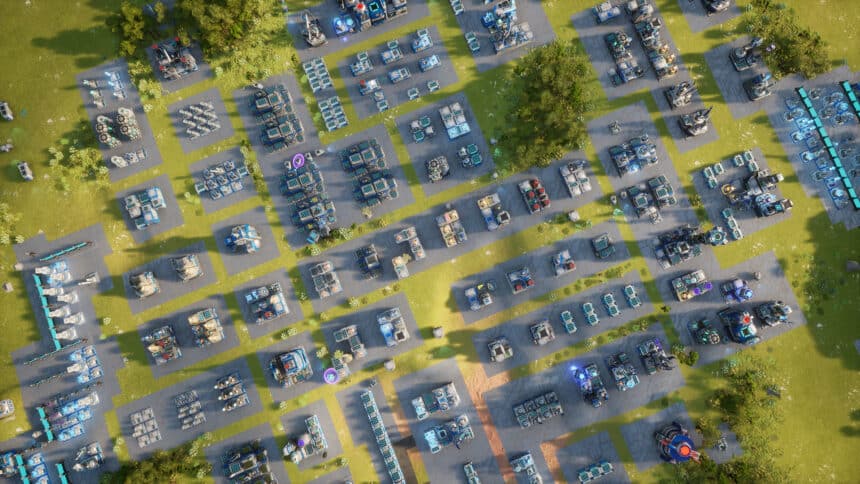RTS automation games are one of the most addictive genres to play especially if you’re obsessed with optimization. The devs over at Stage Games Inc. are giving us a fresh take on this genre with their game, Desynced. It’s nice to see that they are steering away from the usual conveyor belt approach which is already common in other popular automation games that I’ve played like Factorio and Dyson Sphere Program.
Let’s take a look at our first impressions of Desynced and see what unique experiences this early-access title has to offer.
Presentation
Desynced sets you up on a randomly generated planet and ELAIN (Emergent Logistics Artificial Intelligence Network), an AI from your mothership to assist you. The long-term goal of this game is to repair your mothership and escape the planet. This sandbox premise sounds similar to Factorio where your goal is to build a rocket ship.

Deploying my base for the first time felt like I was playing Red Alert 2. The overall map environment also had some influences on Starcraft and Dune.
I like the fact that Desynced has multiplayer support as well so you can do both Co-op and PvP. I could imagine scheduling a weekend with the gang and immersing ourselves in this large planet and start building away. But playing Desynced in single-player already provides a bigger challenge.
Buildings & Components
Buildings are the basic structures that you will need to produce raw materials and survive the bug onslaughts. These buildings have their own Component slots. These components differ by size and these are Internal, Small, Medium, and Large.

In the first hours of your playthrough, you’ll mostly focus on building Small and Medium Components. You’ll be building Fabricators, Assemblers, and more. Don’t miss out on Internal Components because these serve as “buffs” for your bots and buildings in the later stages of Desynced.
I haven’t reached into the Large Components section of the game because of how much content Desynced surprisingly has for an early-access title.
Automation
The automation interface of Desynced reminds me of Mass Effect in terms of the UI. The experience of automating a bot felt like coding a game in Unity. Honestly, this portion of automating each bot and building isn’t my thing. I tend to focus more on seeing that each structure that I build in Desynced has its own purpose.

Most of the buildings in the game have some default automation set up already. I didn’t feel the need to get into the nitty gritty of coding each bot to do something for me. Setting bot behaviors also requires research in the game’s Tech Tree.

However, I did like the other Internal Components that I get to unlock once I’ve completed researching the Basic Tech Tree. The Auto-repair Kit is very helpful to ensure your survival and the Sign Board comes in handy so I can easily find the bots that I manually control.
Bot Creation

Bots are going to be your main work units as well as combat units in Desynced. I was surprised myself while I playing this. This reminded me of my time playing Mars First Logistics minus the rage physics.

Although the bots in this game don’t make you feel like you’re building Legos from scratch, I enjoyed building these bots according to what their role is. There are worker bots, miner bots, and there are some custom bots where you can attach certain components that you like.

Once you create your bot, you can immediately assign them to your logistics network so they can automatically deliver materials to certain buildings. You can also control them manually if you want to send them into exploration or equip them with turrets to fight the bugs scattered on the map.
Exploration & Combat

The command center already includes its own internal power grid to energize your bots and structures. It is your responsibility to expand your power grid so you can explore more of the planet.

Your bots can briefly leave your base’s power grid but take note that they have a limited range to explore outside. Once your bots’ energies deplete, they will move slowly and they won’t be able to perform their work duties well so if you want to give them a recharge, they need to go back to your base. Expect to also build plenty of Power Fields in the early game.

Desynced also presents us with unique ruins to discover around the map. Each ruin you discover most of the time has its own circuit board puzzle along with a specific material that you need to deliver in order to unlock resources.

If you’re lucky, there are also structures that will immediately give you free resources while some deserted buildings will require you to research more advanced tech.

There are also anomalies that you can examine but be careful because some are disguised as viruses that can disrupt your network. You’ll be surprised later that Desynced has a very comprehensive Tech Tree for an early access title.

The combat feels like it needs some improvement. My turret bots slow down frequently whenever I run away from enemy waves and I’m not sure if this behavior is intentional.
Rebuilding these bots also take up a lot of time. So these incidents led me to constantly ask myself which tasks to prioritize first: researching the tech tree or optimizing my base by constructing more bots and buildings.
Tech Trees & Material Production
The tech tree is the most challenging when playing Desynced and this is where the game feels like it’s a long grind. I wish that Desynced had some speed options so I can quickly see if I’m optimizing the right processes.

While I do appreciate the refresher tutorial whenever I start a new game, building your base efficiently has a steep learning curve. In fact, I did three restarts just to figure out how to get better at constructing buildings and units as well as producing materials faster. Most raw materials by default infinitely produce as long as you have the requirements.

So my advice for those who are diving into Desynced, be patient in reading through the Codex and ELAIN’s tooltips because this will really help you understand the mechanics of how logistics and production work on this planet.

Also when you’re starting to craft more advanced materials, set a limit instead of letting it produce infinitely by default. This is actually the reason why I kept creating a new game because I get paralyzed on what to do next once I see that I’m not producing materials as much as I thought.
The Verdict
After playing for over 15 hours, I can say that Desynced is such a challenging and immersive experience. Though I enjoy watching conveyor belts in other RTS production games, my mind needs a break from seeing complex routes. Just sit back, relax, and watch the WiFi bots handle the logistics.

While this early access game has a steep learning curve, it does feel rewarding when you get to optimize your base especially when you feel like you’re never running out of resources.
Facing enemies can be annoying for the most part especially if you’ve built a massive bot army with auto-repair kits, only to realize that you’ll get mad once you see most of them get obliterated by a horde of Scale Worms.
Grinding for resources can be punishing in the beginning, especially if you don’t have an efficient base of operations but this is where Desynced shines. This early-access automation RTS game challenges you to think of the best ways of optimizing your base with the help of your AI bots.
What do you think of our first impressions of Desynced? Are you getting it on Steam? Let us know in the comments section.










